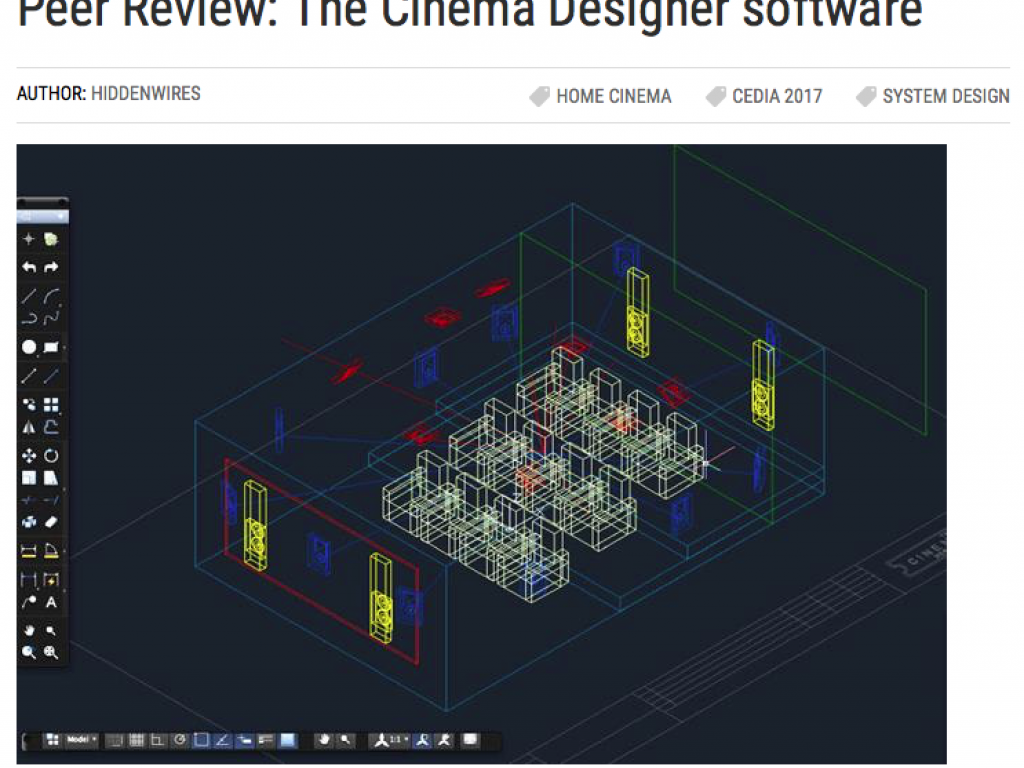Posted on 26th January 2018

Ian Trudgeon, director at UK-based smart home specialist thinkingbricks, reviews TCD for Hidden Wires magazine:
We use The Cinema Designer software as the first step for all our cinema proposals to scope out the overall solution for a client. We now do this regardless of the size of the room or potential budget, so that we have a specific approach to the design and performance of all our media rooms and cinema solutions.
Designing a “proper” cinema room is based squarely in mathematics (room dimensions & volume, seating layout within room floor area) and physics (performance of sound waves within the room, size and brightness of image dependent on screen size and light output of the projector). The software takes ALL of these considerations into account, building from the initial basis of the room itself by considering the audio amplification, video input and outputs, acoustic performance of the coverings of the surfaces and selection of the equipment for the room. You know at that point that you have a solid, logical platform for the room. It makes it easier when you are managing the compromises that sometime occur in the final stages of designing and finalising the eventual install.
We choose to use TCD because it provides a single resource for a system proposal, versus all the previous single iPhone apps/Excel spreadsheets and Word documents we have used historically. Rather than having a series of separate sources of information, we now have a unified document for the system we are proposing.
With the breakdown of the products and an example of a room visualisation included in the final proposal, even the most discerning, detail-focused clients have everything they need to make initial decisions. We find the documents produced prompt useful discussion and engage the client with the solution we are presenting.
With the new Media Room plug-in, we will be able do this for rooms based around large screen OLED or LCD TVs, as well as the original projector and screen based calculations.
There is also a constant stream of updates incoming, with the new ranges of products being included always increasing, which gives us added flexibility.
I like the step-by-step process the software takes you through to get to the solution. You start by setting the room dimensions, and telling the programme the makeup of the room (wall materials, ceiling make up and flooring). From there you set the video parameters, such as screen size, projector manufacturer type and position which guides the seating that works best within the room.
A clever feature is the ability to be able look at how the video aspects will work for the audience, in line with specific technical parameters (such as SMPTE and THX standards).
You can also adjust the seating layouts and heights of rear seating and there is a visual plan of how that will work best to guide any further adjustments.
The next stage inputs the audio design, then the speaker selection and amplification. The programme again guides you to the number of channels you require and tells you when the relevant equipment has covered the requirements, and what the performance will be sitting in the “money seat”!
The ability to print out the full proposal, including product specifications and a visual render of an example room is a great start to showing the client that their room has been fully considered from the outset, and with relatively little time spent at the laptop.
You don’t get a second chance to make a first impression, and TCD ensures they can see you are the expert and have developed a bespoke solution for them. The online resource page also allows you to look through previously created rooms at a top level, so you can see the changes you have made to each iteration, or a similar project which may meet a new client’s brief which can be sent if the deadline is tight.
The ability to brand your proposal is great, and ensures your name features prominently throughout the review process with clients.
The recent addition of audio and video calibration reports furthermore enables the document to continue as a working document for the project, when the time to install and commission the system comes.